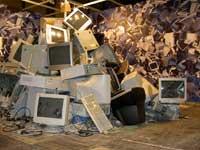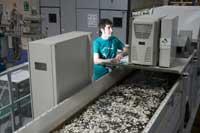Each residue in place

There is no more to see how many electrical and electronic devices exist in the market to understand the complexity that can be the recycling of them. First, we must classify these useful and differentiate the components. Then each component will make a different path.
The components of electronic devices are usually iron, lead, plastic or aluminum, among others. Some of them are easily separable by their color, appearance and weight. Others, however, cannot be differentiated according to these characteristics, but are distinguished by technological advances.
Technological advances in technology

Identification and separation based on the technology of near infrared spectroscopy. (Photo: Gaiker) .
At present, practically all types of materials and waste can be differentiated. For this purpose, they use sensors such as new automatic separation technologies. The most prominent technologies are based on near infrared spectroscopy (NIR), artificial vision, laser or X-ray. All these techniques allow to identify and differentiate the material according to its characteristics, color, transparency, structure and shape.
These sensors are placed on a conveyor belt. This tape works at high speed and on it are distributed the materials to separate. The sensor identifies the dispersed products on the tape and detects their position. The separation is done at the end of the tape and the materials are diverted selectively to their place.
These technologies are flexible and could be used not only in the separation of electrical and electronic waste, but also in the separation of waste such as the classification of plastic derived from these containers (depending on the type of plastic), the removal of chlorinated substances, the classification according to the color of the glass, the separation and classification of paper according to their quality, etc.

The elements of similar color are characterized by an artificial vision technology. (Photo: Tecnalia).
At present, sensor separation systems tend to combine both technologies in the same equipment. The interaction of both technologies allows to increase the performance and flexibility of separation.
Some of these technologies could be applied especially to metal identification and separation. In fact, in electronic waste a manual separation of metals has been produced, which makes it impossible to separate similar metals of color, shape and weight. For this reason, the separation of elements of the same color, such as aluminium, nickel or stainless steel, is done through artificial vision technology. These technologies can also be used for the recovery of fractions rich in metals from vehicles, electric and electronic waste. One of the main advantages of these systems is the detection of non-magnetic materials, which cannot be effectively separated by conventional techniques.
For many years these waste and materials have been deposited in landfills without any type of treatment, with the consequent risk of contamination. At present, technological advances have allowed advances in the separation of these materials.
Published in 7K.
Buletina
Bidali zure helbide elektronikoa eta jaso asteroko buletina zure sarrera-ontzian











